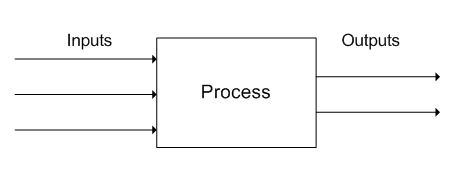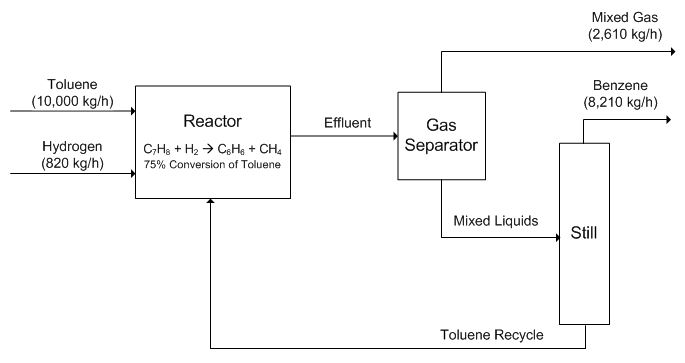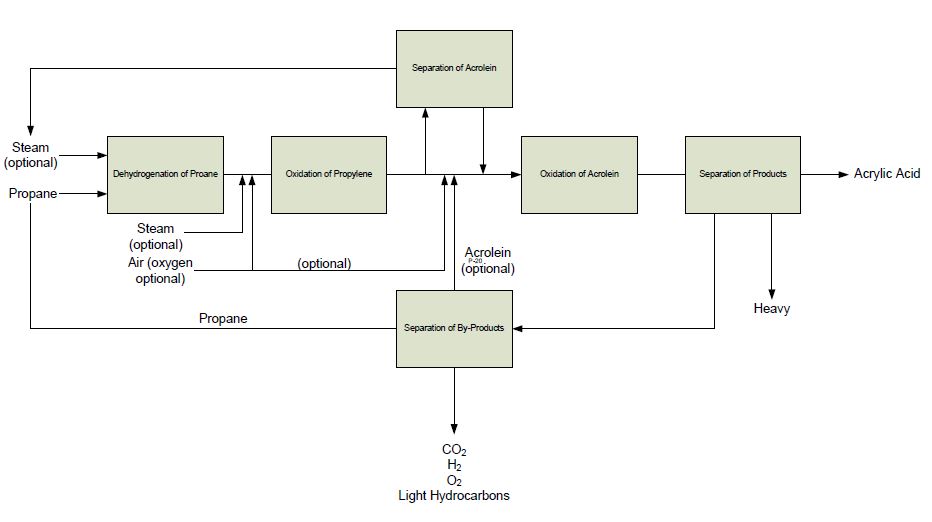Block Flow Diagram: Difference between revisions
Npinkerton (talk | contribs) |
|||
| (33 intermediate revisions by 4 users not shown) | |||
| Line 1: | Line 1: | ||
<br> |
|||
Title: Block flow diagram |
|||
Author: Nick Pinkerton, Karen Schmidt, and James Xamplas (ChE 352 in Winter 2014) |
|||
Steward: David Chen, Fengqi You |
|||
Date Presented: January 15, 2013 /Date Revised: January 18, 2013 |
|||
Date Presented: February 2, 2014 |
|||
<br> |
|||
<!-- Table of Contents --> |
|||
__TOC__ |
|||
==Introduction== |
==Introduction== |
||
A block flow diagram (BFD) is a drawing of a chemical processes used to simplify and understand the basic structure of a system. A BFD is the simplest form of the flow diagrams used in industry. Blocks in a BFD can represent anything from a single piece of equipment to an entire plant. For a complex process, block flow diagrams can be used to break up a complicated system into more reasonable principle stages/sectors. |
|||
==Overview== |
==Overview== |
||
===Uses=== |
===Uses=== |
||
Creating a BFD is often one of the first steps in developing a chemical process. Different alternatives can be easily and inexpensively compared at an early stage using simple BFDs. Once alternatives have been chosen, the BFD serves as a starting point for a complete process flow diagram (PFD). |
|||
| ⚫ | BFD |
||
| ⚫ | A BFD is a useful tool for reports, textbooks and presentations when a detailed process flow diagram is too cumbersome. These models allow for the reader to get an overall picture of what the plant does and how all the processes interact. These can be understood by people with little experience with reading or creating flow diagrams (Towler and Sinnott, 2013). |
||
===Models=== |
===Models=== |
||
BFDs come in many forms and styles. They can be extremely simple or very detailed in their explanation of a process. |
BFDs come in many forms and styles. They can be extremely simple or very detailed in their explanation of a process. |
||
====I/O Diagrams==== |
====I/O Diagrams==== |
||
The simplest form of BFD, the I/O (input/output) |
The simplest form of BFD, the I/O (input/output) diagram (Biegler et al., 1997), provides the material streams entering and exiting the process. The diagram is modeled below using arrows entering and exiting a process box to represent the inputs and outputs, respectively. |
||
[[File:Io_example.JPG|center|frame|Figure1. I/O Diagram]] |
[[File:Io_example.JPG|center|frame|Figure1. I/O Diagram]] |
||
====Block Flow Plant Diagram==== |
====Block Flow Plant Diagram==== |
||
This model of flow diagram is used to explain the general material flows throughout an entire plant. They will be generalized to certain plant sectors or stages. These |
This model of flow diagram is used to explain the general material flows throughout an entire plant. They will be generalized to certain plant sectors or stages. These documents would help orient workers to the products and important operation zones of a chemical facility (Peters and Timmerhaus, 2003). |
||
====Block Flow Process Diagram==== |
====Block Flow Process Diagram==== |
||
This model will concentrate on a particular sector/area of a chemical plant. This would be a separate flow diagram that details what would have been present inside of one of the blocks in the plant diagram. These diagrams may be more or less complicated than the plant diagram but will focus on only a small sub-section of the overall process. |
This model will concentrate on a particular sector/area of a chemical plant. This would be a separate flow diagram that details what would have been present inside of one of the blocks in the plant diagram. These diagrams may be more or less complicated than the plant diagram but will focus on only a small sub-section of the overall process (Peters and Timmerhaus, 2003). |
||
===Conventions=== |
===Conventions=== |
||
There are several conventions regarding the construction of BFDs that are used in the engineering community. |
There are several conventions regarding the construction and format of BFDs that are commonly used in the engineering community. Some of the recommended conventions are: |
||
# Operations/equipment are represented with blocks |
|||
| ⚫ | |||
| ⚫ | |||
| ⚫ | |||
| ⚫ | |||
| ⚫ | |||
| ⚫ | |||
| ⚫ | |||
| ⚫ | |||
| ⚫ | |||
| ⚫ | |||
| ⚫ | |||
| ⚫ | |||
| ⚫ | |||
| ⚫ | |||
==Example 1: Production of Benzene== |
==Example 1: Production of Benzene== |
||
Toluene and hydrogen are used as [https://processdesign.mccormick.northwestern.edu/index.php/Define_product_and_feed feed stocks] for the production of benzene. The toluene and hydrogen are sent |
Toluene and hydrogen are used as [https://processdesign.mccormick.northwestern.edu/index.php/Define_product_and_feed feed stocks] for the production of benzene. The toluene and hydrogen are sent to a reactor, and the effluent is sent to a gas separator where the noncondensable gases are discharged from the system. The bottoms of the separator provides a liquid feed to a still where the lighter benzene gas is collected as the distillate and the bottom toluene draw is recycled back into the reactor. The BFD provided shows the reaction, the stream names, and the mass flow of the inlets and outlets. There are many components of this system (heat exchangers and pumps, etc.) that are not represented because they are not vital for an understanding of the main features of the process. |
||
[[File:Benzene_prod_example.JPG|center|frame|Block flow process diagram for the production of benzene]] |
[[File:Benzene_prod_example.JPG|center|frame|Figure 2. Block flow process diagram for the production of benzene (Turton et al., 2012)]] |
||
==Example 3: Caprolactam From Toluene== |
|||
Block Flow Diagram Example 3: Caprolactam From Toluene |
|||
==Example 2: Oxidation of Propene to Acrylic Acid== |
|||
Propane is dehydrogenated to propene, which is oxidized to acrolein first and then further oxidized to acrylic acid. The products are separated in the end to give acrylic acid and various by-products. The by-products are further separated to yield a propane recycle stream. Each block in the BFD provided shows what each individual unit is doing along every step of the process. It also shows inlet and outlet streams, as well as byproducts and recycle streams. A BFD in this style is helpful so that all materials can be seen, every step of the process is outlined, and byproducts can be taken into consideration for waste removal/treatment. |
|||
[[File:Acrylicacidexample.JPG|center|frame|Figure 3. Block flow process diagram for the production of acrylic acid (Khoobiar et al., 1984)]] |
|||
==References== |
==References== |
||
| ⚫ | |||
| ⚫ | |||
Khoobiar S, Porcelli R, inventor; The Halcon Sd Group Inc., assignee. Conversion of propane to acrylic acid. European patent EP0117146. 1984 May 5. |
|||
Peters MS, Timmerhaus KD. Plant Design and Economics for Chemical Engineers. 5th ed. New York: McGraw Hill; 2003. |
|||
| ⚫ | |||
Seider WD, Seader JD, Lewin DR. Process Design Principles: Synthesis, Analysis, and Evaluation. 3rd ed. New York: Wiley; 2004. |
|||
| ⚫ | |||
* Seider, W.D., Seader, J.D., and Lewin, D.R. (2004). ''Process Design Principles: Synthesis, Analysis, and Evaluation.'' New York: Wiley. |
|||
Turton R, Bailie RC, Whiting WB, Shaewitz JA, Bhattacharyya D. Analysis, Synthesis, and Design of Chemical Processes. 4th ed. Upper Saddle River: Prentice-Hall; 2012. |
|||
Latest revision as of 22:23, 1 March 2015
Author: Nick Pinkerton, Karen Schmidt, and James Xamplas (ChE 352 in Winter 2014)
Steward: David Chen, Fengqi You
Date Presented: February 2, 2014
Introduction
A block flow diagram (BFD) is a drawing of a chemical processes used to simplify and understand the basic structure of a system. A BFD is the simplest form of the flow diagrams used in industry. Blocks in a BFD can represent anything from a single piece of equipment to an entire plant. For a complex process, block flow diagrams can be used to break up a complicated system into more reasonable principle stages/sectors.
Overview
Uses
Creating a BFD is often one of the first steps in developing a chemical process. Different alternatives can be easily and inexpensively compared at an early stage using simple BFDs. Once alternatives have been chosen, the BFD serves as a starting point for a complete process flow diagram (PFD).
A BFD is a useful tool for reports, textbooks and presentations when a detailed process flow diagram is too cumbersome. These models allow for the reader to get an overall picture of what the plant does and how all the processes interact. These can be understood by people with little experience with reading or creating flow diagrams (Towler and Sinnott, 2013).
Models
BFDs come in many forms and styles. They can be extremely simple or very detailed in their explanation of a process.
I/O Diagrams
The simplest form of BFD, the I/O (input/output) diagram (Biegler et al., 1997), provides the material streams entering and exiting the process. The diagram is modeled below using arrows entering and exiting a process box to represent the inputs and outputs, respectively.
Block Flow Plant Diagram
This model of flow diagram is used to explain the general material flows throughout an entire plant. They will be generalized to certain plant sectors or stages. These documents would help orient workers to the products and important operation zones of a chemical facility (Peters and Timmerhaus, 2003).
Block Flow Process Diagram
This model will concentrate on a particular sector/area of a chemical plant. This would be a separate flow diagram that details what would have been present inside of one of the blocks in the plant diagram. These diagrams may be more or less complicated than the plant diagram but will focus on only a small sub-section of the overall process (Peters and Timmerhaus, 2003).
Conventions
There are several conventions regarding the construction and format of BFDs that are commonly used in the engineering community. Some of the recommended conventions are:
- Operations/equipment are represented with blocks
- Material flows are represented with straight lines with arrows giving the direction of flow
- Lines are horizontal and/or vertical, with turns at 90 degree angles
- Flows go from left to right whenever possible
- If lines cross, the horizontal line is continuous and the vertical line is broken
- Light streams (gases) are typically closer to the top of the BFD than are heavy streams (liquids or solids)
- Critical information unique to the process (such as a chemical reaction) is supplied
- A simplified material balance should be provided (Seider et al., 2004)
Example 1: Production of Benzene
Toluene and hydrogen are used as feed stocks for the production of benzene. The toluene and hydrogen are sent to a reactor, and the effluent is sent to a gas separator where the noncondensable gases are discharged from the system. The bottoms of the separator provides a liquid feed to a still where the lighter benzene gas is collected as the distillate and the bottom toluene draw is recycled back into the reactor. The BFD provided shows the reaction, the stream names, and the mass flow of the inlets and outlets. There are many components of this system (heat exchangers and pumps, etc.) that are not represented because they are not vital for an understanding of the main features of the process.
Example 2: Oxidation of Propene to Acrylic Acid
Propane is dehydrogenated to propene, which is oxidized to acrolein first and then further oxidized to acrylic acid. The products are separated in the end to give acrylic acid and various by-products. The by-products are further separated to yield a propane recycle stream. Each block in the BFD provided shows what each individual unit is doing along every step of the process. It also shows inlet and outlet streams, as well as byproducts and recycle streams. A BFD in this style is helpful so that all materials can be seen, every step of the process is outlined, and byproducts can be taken into consideration for waste removal/treatment.
References
Biegler LT, Grossmann IE, Westerberg AW. Systematic Methods of Chemical Process Design. Upper Saddle River: Prentice Hall; 1997.
Khoobiar S, Porcelli R, inventor; The Halcon Sd Group Inc., assignee. Conversion of propane to acrylic acid. European patent EP0117146. 1984 May 5.
Peters MS, Timmerhaus KD. Plant Design and Economics for Chemical Engineers. 5th ed. New York: McGraw Hill; 2003.
Seider WD, Seader JD, Lewin DR. Process Design Principles: Synthesis, Analysis, and Evaluation. 3rd ed. New York: Wiley; 2004.
Towler G, Sinnott R. Chemical Engineering Design: Principles, Practice and Economics of Plant and Process Design. 2nd ed. Boston: Elsevier; 2013.
Turton R, Bailie RC, Whiting WB, Shaewitz JA, Bhattacharyya D. Analysis, Synthesis, and Design of Chemical Processes. 4th ed. Upper Saddle River: Prentice-Hall; 2012.


